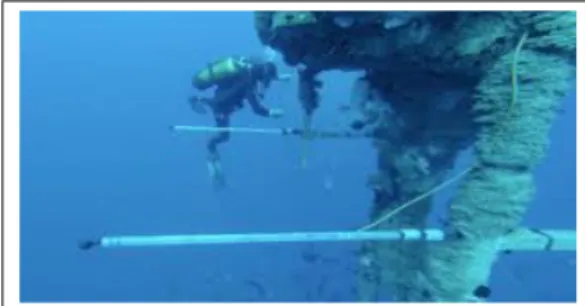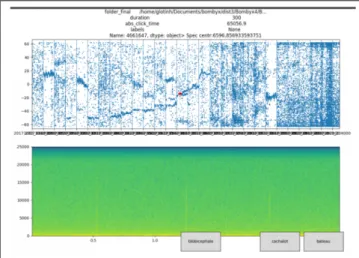HAL Id: hal-03199965
https://hal.archives-ouvertes.fr/hal-03199965
Submitted on 16 Apr 2021
HAL is a multi-disciplinary open access
archive for the deposit and dissemination of
sci-entific research documents, whether they are
pub-lished or not. The documents may come from
teaching and research institutions in France or
abroad, or from public or private research centers.
L’archive ouverte pluridisciplinaire HAL, est
destinée au dépôt et à la diffusion de documents
scientifiques de niveau recherche, publiés ou non,
émanant des établissements d’enseignement et de
recherche français ou étrangers, des laboratoires
publics ou privés.
STEREO TO FIVE-CHANNELS BOMBYX
SONOBUOYS : FROM FOUR YEARS CETACEAN
MONITORING TO REAL-TIME WHALE-SHIP
ANTI-COLLISION SYSTEM
Paul Best, Sebastian Marzetti, Marion Poupard, Maxence Ferrari, Sébastien
Paris, Ricard Marxer, Olivier Philipe, Valentin Gies, Valentin Barchasz, Hervé
Glotin
To cite this version:
Paul Best, Sebastian Marzetti, Marion Poupard, Maxence Ferrari, Sébastien Paris, et al.. STEREO
TO FIVE-CHANNELS BOMBYX SONOBUOYS : FROM FOUR YEARS CETACEAN
MONITOR-ING TO REAL-TIME WHALE-SHIP ANTI-COLLISION SYSTEM. e-Forum Acusticum 2020, Dec
2020, Lyon, France. �hal-03199965�
STEREO TO FIVE-CHANNELS BOMBYX SONOBUOYS : FROM FOUR
YEARS CETACEAN MONITORING TO REAL-TIME WHALE-SHIP
ANTI-COLLISION SYSTEM
Best P.
1Marzetti S.
3Poupard M.
1Ferrari M.
1Paris S.1
Marxer R.
1Philippe O.
2Gies V.
3Barchasz V.1, 3
Glotin H.
1,3 1Univ. Toulon, AMU, CNRS, LIS, DYNI, Marseille, France
2
OSEAN SAS, Pradet, France
3SMIoT INPS Toulon, France
paul.best@univ-tln.fr, glotin@univ-tln.fr
1. INTRODUCTION
Sperm whale groups live and hunt in the Pelagos sanctuary all year round. It is believed that they make use of canyons and steep sea floors to ease their hunt for prey. The south side of the Port-Cros island is an ideal place to observe these animals, being near the coast for easier installation, as well as right next to Sperm whales’ hunting grounds such as the Stoechades Canyon among others. In this area, the sea floor drops to -2000 meters in a few kilometers. In this paper, we describe two versions of a passive acoustic monitoring project that started in 2013 called Bombyx [1]. Passive acoustic monitoring describes the approach of an-imal biology studies via acoustic surveillance (placing mi-crophones or hydrophones and listening to the acoustic ac-tivity of animals). For animals like Sperm whales, who rely on sound for not only communication but also navigation in the darkness of the depths, passive acoustic monitoring is most relevant. Multi hydrophones arrays allow the tri-angulation of the acoustic emitters, and thus to follow the animal’s movement from a distance. In this paper, we will demonstrate several advancements in monitoring methods, all made possible by the Bombyx project.
2. BOMBYX-1 2.1 Material
The first implementation of the Bombyx project took form as an underwater buoy Fig.1, floating 25 meters deep, an-chored on a 275 m deep sea floor. The buoy is autonomous, relying on battery power, recording for dozens of days for several recording sessions. This approach offers a greater observability compared to listening from a boat or from a station connected to land via cable. The two hydrophones recorded at 50 kHz using the JASON sound card [6] for a total of 112 days spread over 4 years.
2.2 Method
For such a large amount of data, the task of analysis in search for acoustic presence of Sperm whales is far from trivial. It is not possible for human annotators to listen to every piece of recording, and automatic detectors are not
Figure 1. Bombyx-1 during installation with its 2 hy-drophones, aperture of 1.83 m.
reliable enough yet to base behavioral statistics upon. To allow an efficient browse of the large amount of recordings, we developed a custom made interface shown in Fig.2 [2]. This interface first relies on a high recall but low precision click detector. By applying a Teager Kaiser energy opera-tor on the signal after a band pass filter centered at 12.5 kHz [3], most Sperm whale clicks are detected, among other acoustic impulses such as pilot whale’s clicks, en-gine sounds and others. We then computed the TDoA of those detected impulses between the two hydrophones. The scatter plot of TDoAs over time allows the identifica-tion of moving acoustic emission. Such an interface allows to go through 10 hours of signal in one look, easily identi-fying any potential moving acoustic emitter, which Sperm whales usually are. To then distinguish between Sperm whales and other moving acoustic emitters (boats or pilot whales), our interface allows to select a detected impulse, and to plot the spectrogram of its surrounding signal as well as listening to it.
This interface allowed the construction of a dataset con-sisting of 2312 Sperm whale samples, 154 Pilot whale (G. m.)samples, and 3087 noise samples. Each of these belong to individual tracks.
3. BOMBYX-2 3.1 Material
The second implementation of the Bombyx project is yet to be placed into the water, in early 2021 (see Fig.3). This
Figure 2. Annotation tool for the bombyx project. On top, the TDoA of each detected click versus time. At the bot-tom, the spectrogram of the sound surrounding the selected click (in red). The 3 buttons serve to annotate the selected click as Sperm whale, pilot whale, or noise.
time, a floatability variation system will allow for both 20 m deep recording and surface wireless data transmission, for an estimated battery life of 6 months. This real time data transmission is necessary since this sonobuoy will serve as an alert system for Sperm whale and fin whale presence, reducing the collision risks via speed regula-tion or course modificaregula-tion. An array of 5 hydrophones will allow not only for azimuth estimation, but also el-evation, and distance of the acoustic source. Bombyx-2 will be equipped with a PIC32MZ micro-processor cou-pled with the Qualilife HighBLue JASON sound card [6], allowing for high frequency recording and embedded com-putations such as Convolutional Neural Network (CNN) forward pass, while consuming energy.
Figure 3. Bombyx-2 with the 4G transmitter and the floatability variation system. The 5 hydrophones array is fixed at the bottom.
3.2 Method
The data collected and annotated during Bombyx-1 served to optimize an analog detection system as well as to train a Convolutional Neural Network Fig.4 for Sperm whale detection. The analog detection system makes use of band pass and low pass filters to compare the energy above 8kHz with the background noise level. High frequency energy peaks are thus detected as potential Sperm whale clicks. The peaks’ duration and periodicity are checked against the possible ranges for Sperm whale clicks using a state machine. This analog detection system showed an area un-der curve of 75% on the Bombyx-1 annotated data. This allows for an ultra low power (17 A) always on detector. The following verification of the acoustic emissions makes use of a convolutional neural network for a more robust classification of the detected acoustic impulse [5]. A low complexity network of approximately 10 thousand param-eters, with a Mel-Spectrum frontend followed by 3 depth-wise convolution layers of 64 features each was designed. Trained on the Bombyx-1 data, and tested on the 2017 recordings (none of which were present in training), the model showed a performance of 98% of AUC on the train-ing set and 92% of AUC on the test set. After validation
Figure 4. left ROC curve of the CNN binary classifier of Sperm whales, right topology of the CNN.
by the CNN, the times of arrivals of several Sperm whale clicks will be recorded using the analog detector at a time resolution of 50 ns. All the hydrophones will be point-ing in the same direction (downwards), allowpoint-ing for the difference of phase method to infer the 3 dimensional po-sition of the acoustic source at each click [4]. Integrating the inferred positions over several dozens of clicks will al-low for a more robust estimation. The buoy will then rise to the surface and transmit to our lab the recorded times of arrival as well as sampled signals via 4G. After human verification, until the robustness of the system is validated, the alerts of Sperm whale or fin whale presence will be transmitted to authorities, and measures will be taken to minimize the collision risk accordingly.
4. ACKNOWLEDGEMENT
We thank Region PACA and Programma Interreg Italia-Francia Marittimo 2014-2020, Projet GIAS / Progetto GIAS, Whale anti collision alert system for support to P. Best’s Phd. We thank SMIoT UTLN and INPS for sound card co-development and low power AI. We thank ANR-20-CHIA-0014-01 National Chair in Artificial Intelligence
ADSIL (H. Glotin), and ANR-18-CE40-0014 SMILES. 5. REFERENCES
[1] Glotin et al. ”Projet VAMOS : Vis´ees a´eriennes de mammif`eres marins jointes aux observations acous-tiques sous-marines de la bou´ee BOMBYX et An-tar`es: nouveaux mod`eles en suivis et lois al-lom´etriques du Physeter macrocephalus, Ziphius cavi-rostris et autres c´etac´es” Pelagos Sanctuary Research Reports, http://sabiod.org/pub/PELAGOS_ VAMOS.pdf, Univ. Toulon, 2017
[2] M. Poupard ”Contributions en M´ethodes Bioacous-tiques Multi´echelles.” PhD Thesis Universit´e de Toulon, 2020.
[3] Kandia, V. and Stylianou, Y. ”Detection of Sperm whale clicks based on the teager–kaiser energy oper-ator” Applied Acoustics, 67(11-12) :1144–1163, 2016. [4] Poupard, M., et al. Real-time passive acoustic 3D tracking of deep diving cetacean by small non-uniform mobile surface antenna. International Conference on Acoustics, Speech and Signal Processing (ICASSP). IEEE, 2019.
[5] Ferrari, M., et al. ”DOCC10 : Open access dataset of marine mammal transient studies and end-to-end CNN classification” International Joint Conference on Neu-ral Networks (IJCNN). IEEE, 2020.
[6] Barchasz, V. and Gies, V. and Marzetti, S. and Glotin, H. A novel low-power high speed accurate and pre-cise DAQ with embedded artificial intelligence for long term biodiversity survey. The Proc. of the Acustica Symp. 2020. European Acoustics Association and So-ciety of France.

